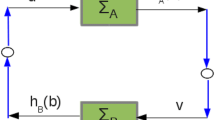Abstract
This paper focuses on Boolean automata networks and the updatings of automata states in these networks. More specifically, we study how synchronous updates impact on the global behaviour of a network. On this basis, we define different types of network sensitivity to synchronism, which are effectively satisfied by some networks. We also relate this synchronism-sensitivity to some properties of the structure of networks and to their underlying mechanisms.




Similar content being viewed by others
References
Aldana M (2003) Boolean dynamics of networks with scale-free topology. Phys D 185:45–66
Aracena J, Demongeot J, Goles E (2004a) On limit cycles of monotone functions with symmetric connection graph. Theor Comput Sci 322:237–244
Aracena J, Demongeot J, Goles E (2004b) Positive and negative circuits in discrete neural networks. IEEE Trans Neural Netw 15:77–83
Chandesris J, Dennunzio A, Formenti E, Manzoni L (2011) Computational aspects of asynchronous cellular automata. In: Proceedings of DLT, lecture notes in computer science, vol 6795, pp 466–468. Springer, Berlin
Choffrut C (ed) (1988) Automata networks, lecture notes in computer science, vol 316. Springer, Berlin
Combe P, Nencka H (1997) Frustration and overblocking on graphs. Math Comput Model 26:307–309
Cosnard M, Demongeot J (1985) Iteration theory and its functional equations, lecture notes in mathematics, vol 1163, chap. On the definition of attractors, Springer, Berlin, pp 23–31
Demongeot J, Goles E, Morvan M, Noual M, Sené S (2010) Attraction basins as gauges of robustness against boundary conditions in biological complex systems. PLoS ONE 5:e11,793
Derrida B, Pomeau Y (1986) Random networks of automata: a simple annealed approximation. Europhys Lett 1:45–49
Fatès N (2003) Experimental study of elementary cellular automata dynamics using the density parameter. Discret Math Theor Comput Sci AB:155–166
Floréen P (1992) Computational complexity problems in neural associative memories. PhD thesis, University of Helsinki
Goles E, Olivos J (1981) Comportement périodique des fonctions à seuil binaires et applications. Discret Appl Math 3:93–105
Goles E, Martínez S (1990) Neural and automata networks: dynamical behaviour and applications. Kluwer, Dordrecht
Goles E, Salinas L (2008) Comparison between parallel and serial dynamics of Boolean networks. Theor Comput Sci 396:247–253
Harvey I, Bossomaier T (1997) Time out of joint: attractors in asynchronous random Boolean networks. In: Proceedings of ECAL, MIT Press, Cambridge, pp 67–75
Kauffman SA (1969) Metabolic stability and epigenesis in randomly constructed genetic nets. J Theor Biol 22:437–467
Kleene SC (1956) Automata studies, annals of mathematics studies, vol 34, chap. Representation of events in nerve nets and finite automata, Princeton Universtity Press, Princeton, pp 3–41
Manzoni L (2012) Asynchronous cellular automata and dynamical properties. Natural Comput 11:269–276
McCulloch WS, Pitts WH (1943) A logical calculus of the ideas immanent in nervous activity. Bull Math Biophys 5:115–133
Noual M, Regnault D, Sené S (2012) Boolean networks synchronism sensitivity and XOR circulant networks convergence time. In: Full papers proceedings of AUTOMATA & JAC’2012, electronic proceedings in theoretical computer science, vol 90, Open Publishing Association, pp 37–52
Noual M, Regnault D, Sené S (2013) About non-monotony in Boolean automata networks. Theor Comput Sci 504:12–25
Remy É, Ruet P (2008) From minimal signed circuits to the dynamics of Boolean regulatory networks. Bioinformatics 24:i220–i226
Richard A (2010) Negative circuits and sustained oscillations in asynchronous automata networks. Adv Appl Math 44:378–392
Robert F (1986) Discret iterations: a metric study. Springer, Berlin
Saint Savage N (2005) The effects of state dependent and state independent probabilistic updating on Boolean network dynamics. PhD thesis, University of Manchester
Schabanel N, Regnault D, Thierry É (2009) Progresses in the analysis of stochastic 2D cellular automata: a study of asynchronous 2D minority. Theor Comput Sci 410:4844–4855
Thieffry D, Thomas R (1995) Dynamical behaviour of biological regulatory networks-II. Immunity control in bacteriophage lambda. Bull Math Biol 57:277–297
Thomas R (1973) Boolean formalization of genetic control circuits. J Theor Biol 42:563–585
Thomas R (1991) Regulatory networks seen as asynchronous automata: a logical description. J Theor Biol 153:1–23
Toulouse G (1977) Theory of the frustration effect in spin glasses. I. Commun Phys 2:115–119
Vannimenus J, Toulouse G (1977) Theory of the frustration effect in spin glasses. II. Ising spins on a square lattice. J Phys C 10:L537–L542
von Neumann J (1966) Theory of self-reproducing automata. University of Illinois Press, Champaign
Acknowledgements
This work has been partially supported by the project PACA APEX FRI.
Author information
Authors and Affiliations
Corresponding author
Rights and permissions
About this article
Cite this article
Noual, M., Sené, S. Synchronism versus asynchronism in monotonic Boolean automata networks. Nat Comput 17, 393–402 (2018). https://doi.org/10.1007/s11047-016-9608-8
Published:
Issue Date:
DOI: https://doi.org/10.1007/s11047-016-9608-8




